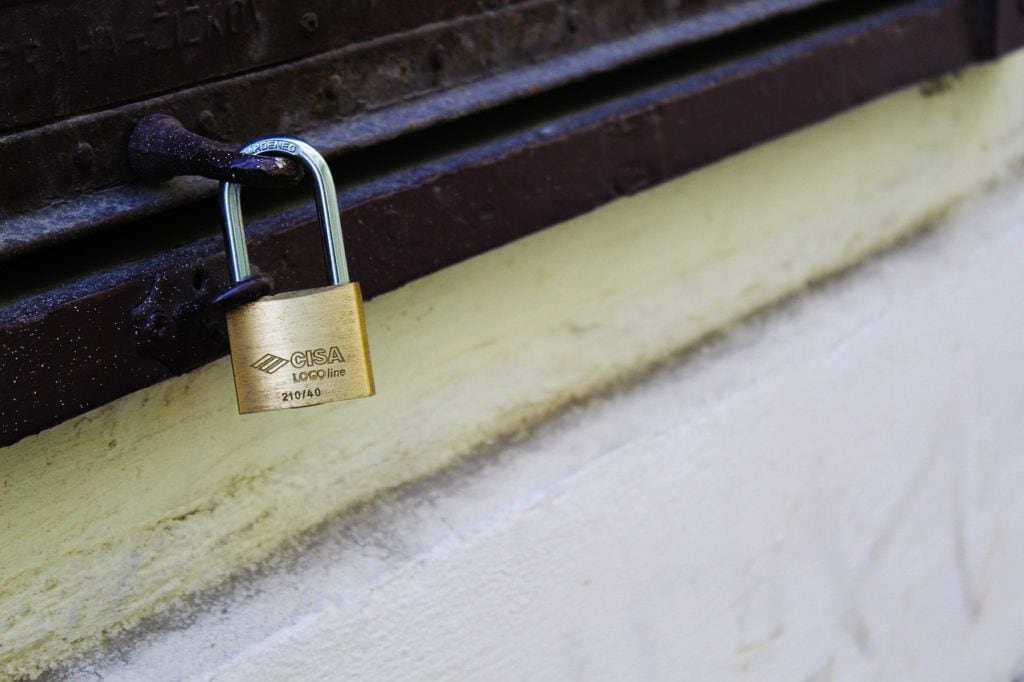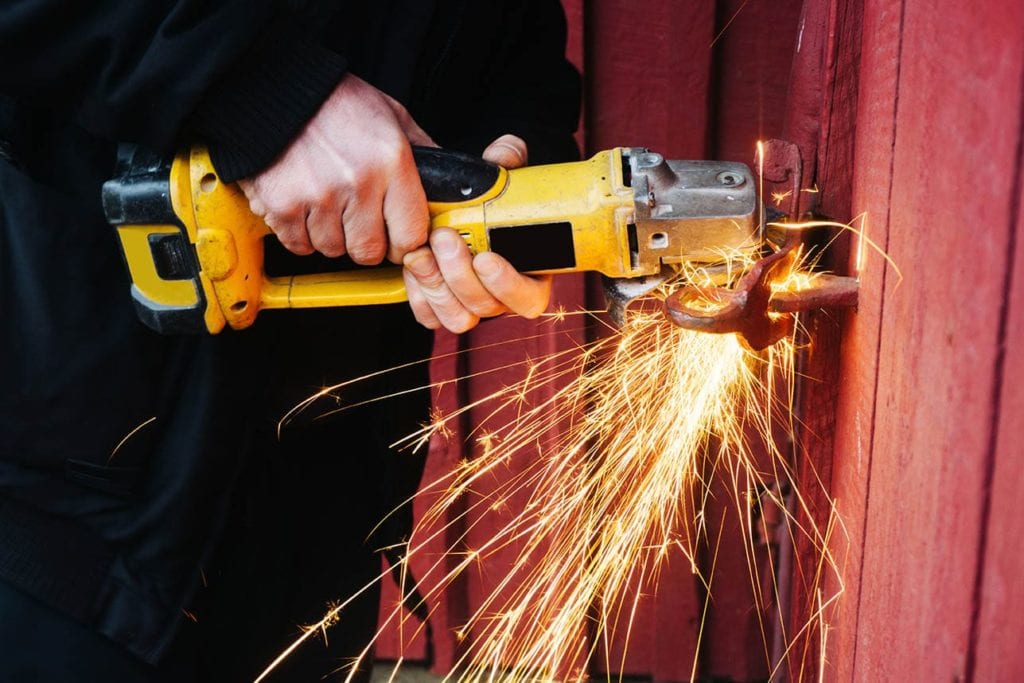How to Cut a Padlock Without Bolt Cutters (9 Quick & Easy Methods)
-

- Last updated:


By far the easiest way to cut a padlock is with bolt cutters. After all, that is exactly what they have been designed for. However, most people do not have bolt cutters sitting around. And you may not want to go out and get bolt cutters just for a single padlock.
Luckily, there are other ways you can cut through a padlock. Many of these ways are a bit more involved than a bolt cutter. There is a reason they were invented, after all. If it was easy to get a padlock off without bolt cutters, then bolt cutters wouldn’t be as needed as they are.
Still, many of these options are doable if you have the right tools nearby. In this article, we’ll go over some of the easiest ways to cut through a padlock without bolt cutters.
The 9 Methods for Cutting a Padlock Without Bolt Cutters
1. Use an Angle Grinder

If you happen to have an angle grinder, you can easily cut through a padlock without needing a bolt cutter. You will need a metal cutoff wheel with your angle grinder as well, but these are not terribly expensive.
Before you start cutting away, though, you will need to wear the proper safety gear. Metal fragments can go flying once you start cutting, so you will need to wear safety goggles and work gloves. The work gloves should be resistant to fire and heat, as you should expect to make sparks while cutting.
Once you have all the necessary safety gear, you can start actually cutting. Hold the blade so that it is perpendicular to the lock. Then, you can begin slowly cutting. You shouldn’t apply too much pressure. Instead, let the tool do all the work for you. If you apply too much pressure, you run the risk of accidentally cutting something else, which is probably the last thing you want to do.
2. Use a Dremel
If you don’t have an angle grinder laying around, you can use a Dremel as well. A Dremel with a cutoff wheel is basically the same as an angle grinder, except that it is smaller. This makes it better for tight quarters, where you may not have the room for an angle grinder. However, their smallness does mean that you will spend more time cutting, as they aren’t as powerful and don’t have as much surface area.
You should be very careful when cutting with a Dremel, as there is a high chance of them breaking. You should use a reinforcement wheel if possible. Take it very slowly to reduce any chance of breaking the wheel.
Of course, wear the proper safety equipment as well!
3. Use a Propane Torch and Hacksaw
This is probably the most impractical method out there. However, it does work. If you don’t have any of the other tools we’ve mentioned, then this may be your only option besides purchasing a pair of bolt cutters.
You can’t take a hacksaw directly to a padlock. Most padlocks are made with hardened steel to prevent this exact situation. However, you can heat up the shackle before you start cutting, which should weaken the steel and allow you to cut through it.
You’ll need a propane torch for this. Simply heat the area where you plan on cutting until it is glowing and obviously as hot as you can get it. Then, shut off your torch and let the lock cool. Once it has cooled, you should be able to cut through it with a hacksaw with ease.
You should wear all the appropriate safety gear when doing this cutting. You should wear goggles and working gloves.
4. Use a Cutting Torch
If you have an A/O torch, you can absolutely blow through a padlock in only a matter of seconds. This method is a bit of an overkill. An A/O torch will absolutely destroy any padlock it comes into contact with. However, if you happen to have a torch handy, this is often one of the most entertaining ways to get through a padlock.
When cutting with an A/O torch, you want to open your oxygen tank all the way and your acetylene tank about a quarter of the way. Set the PSI for the oxygen tank at around 50 PSI. The acetylene should be at about 5 PSI. You can adjust this as you see fit once you start actually using the torch.
Now, spark your torch and adjust the valves accordingly. If you’ve used a torch before, then this will probably be second nature to you. Once the flame is a white cone, you’re ready to cut through the lock. This can be done simply by moving the cutting torch over the shackle. It should cut through the lock pretty easily.
5. Use a Hammer

For cheap padlocks, you may be able to pry the lock open with a hammer. This works best for padlocks that are on things, like cheap luggage locks, for instance. Simply wedge the hammer between the top of the hasp and the body of the lock. Then force it open using the claw end of the hammer. If it is a cheap lock that isn’t particularly robust, this should work quite well.
Alternatively, take the padlock onto the pavement and bash it repeatedly with the hammer. This obviously isn’t possible if the lock is on a fence or otherwise immoveable. For luggage locks and similar padlocks, this option is one of the easiest and most straightforward.
If none of these options work, try hitting the non-locking end of the lock with the hammer. This may cause it to spring free or break the locking mechanism outright.
Hammers are only suitable for cheap padlocks. Most high-quality options are made to stand up against most of these options. Instead, you’ll need to up the ante with one of the other methods we mentioned.
6. Use a Shim
If you’re willing to give it a bit of finesse and patience, you may be able to use a shim to unlock an inexpensive padlock. A shim is a small piece of metal that is shaped so you can shove one end into the top part of the lock, where the shackle goes into the locking mechanism.
To use a shim, you insert the thicker part into the body and wiggle it back and forth. At some point, the lock will spring open and you should be able to open the padlock.
This is a fairly straightforward method, but it does take a lot of patience if you’ve never done it before. Watching a few YouTube videos is highly recommended, as it can give you some idea of what you should be doing. This is one of those things where it is better learned through watching.
7. Lock Picking
Of course, you can always lock pick a padlock as well. This can have varying degrees of difficulty depending on the lock. Some may not be particularly difficult at all, while others are nearly impossible. Generally, the more expensive your lock, the harder it will be to pick it.
To lock pick, you’ll need to take a tension wrench and place it at the bottom of the keyhole. Then, apply the right amount of pressure to cause the plug to rotate. You don’t want it to rotate a lot—just barely. Then you can use a pick to push in the first pin. Just continue to do this for all the pins in the lock. You’ll likely need to move the pin back and forth to catch all the pins. Don’t apply too much pressure, as this can break the lock.
8. Use a Master Key

You may be able to purchase a master key for your lock. These keys can open multiple locks inside a home. Basically, there are a few master keys for the types of locks. You won’t know which master key will open your padlock until you give it a try.
Master keys are great fail-safes for when you lose your primary key. If you want it to open multiple locks within your home, you will need to ensure that all your locks are compatible with each other. Otherwise, you’ll need multiple master keys to unlock everything.
Master keys are best purchased before you need them. However, if your padlock is currently locked, you may be able to find a master key to fit it after the fact. This will require a lot of patience and may cost you a bit of money as well. At this point, it may just be better to move on to the next option.
- Related Read: How To Drill Out A Lock
9. Call a Locksmith

If all else fails, you may just need to call a locksmith. You’re probably reading this article to avoid that exact situation, but sometimes a locksmith is cheaper than purchasing tools to get the padlock open. If you can’t force it open with a hammer or a shim, and you don’t have one of the more advanced tools we’ve discussed, then a locksmith is your best option.
Locksmiths are professionals at opening locks. So, they’re probably better at opening locks than just about anyone. If you’ve tried and tried to open your lock, a locksmith may be your least ditch effort. Most locksmiths will charge between $50 to $100 to come and unlock your lock. It depends on the type of lock you’re dealing with and what the locksmith needs to do to get the lock open to begin with.
Often, the locksmith will simply bring bolt cutters and remove the lock, replacing it with a new one when they’re done. Alternatively, they may be able to make you a new key, depending on the lock. Either way, a locksmith is one of the few sure ways to get the lock open with little effort on your part. Of course, you will need to pay the locksmith
Conclusion
There are countless ways to get a padlock open without bolt cutters. You can use a variety of tools to break the lock, including a Dremel and angle grinder. Alternatively, you can cut the lock open with a torch or cut it with a hacksaw. Some cheaper padlocks can be pounded or pried open with a hammer. Which method works best for you depends on what skills and tools you have at your disposal, as well as the quality of the lock. High-quality locks will be harder to open than cheap options.
You can also unlock the padlock using other means, such as a shim or lock pick. Both of these require a bit of skill and can vary in difficulty. Many advanced locks have measures in place to make lock picking nearly impossible.
If you’ve tried these methods to no avail, you will need to contact a locksmith. While this does cost money, it may be your only option in the case that the lock remains tight no matter what you do. It is often cheaper to hire a locksmith than purchase the required tools yourself, so you may actually save some money if you don’t have an angle grinder or torch laying around.
- See Also: 10 Best Bolt Cutters
Featured Image Credit: bboellinger, Pixabay
Contents



